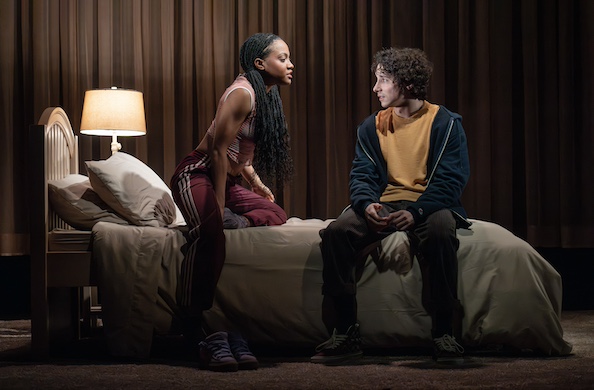The Title Is ‘Jonah,’ but It’s Women Who Make This New Production Soar
The real protagonist of Rachel Bonds’s sometimes slow-moving but beguiling one-act piece is its sole female character, a young woman named Ana.

The title character of Rachel Bonds’s “Jonah” is prominent in roughly the first quarter of the play but then disappears abruptly, and for a long time. Other men will emerge as significant figures, but the real protagonist of this sometimes slow-moving but beguiling one-act piece is its sole female character, a young woman named Ana.
We meet Ana as a 16-year-old scholarship student at an elite institution, where she lives on campus. Gradually, we learn details of the troubled family life she left behind, and of her hope to transcend it using her gifts as a writer. When Jonah, a bright but sweetly self-conscious fellow pupil played with disarming sensitivity by Hagan Oliveras, first attempts to flatter and flirt with her, her instinctual response is defensive: “Shut up,” she tells him, more than once.
Mind you, Ana also lifts her shirt for Jonah, and in a funny and evocative exchange, the two compare fantasies. While Jonah, like many lads his age, focuses on the physical attributes of the opposite sex, Ana, already an inveterate storyteller with a vivid imagination, envisions elaborate romantic scenarios. She spells these out with gusto, despite her clear ambivalence about her attraction to her awkward suitor.
Actress Gabby Beans, who made a sparkling Broadway debut two years ago in a revival of “The Skin of Our Teeth,” invests Ana with a mix of feistiness, vulnerability, and sheer resolve that makes it plain this character isn’t a tease, but rather a survivor whose experiences have left her both eager to appease men and reluctant to trust them. Ms. Bonds discloses this during scenes that unfold over decades, though that passage of time isn’t obvious at first.

We’re introduced to two other young men who become fixated on Ana: Danny, who’s a year older and clearly shares personal history with her, and Steven, an aspiring journalist enrolled in a writing program she enters years later. References are made throughout the play to another, older man, someone who has irreparably affected both Ana and Danny; he never appears onstage but is heard shouting at points, and is described in disturbing detail.
It’s indicated that Jonah benefits from more socio-economic privilege than Ana has enjoyed, and suggested that Steven does; while Danny is less educated, and self-identifies as a lowly “townie” in her college community, we learn that his father has at least provided financial stability. Danny is a particularly vexing figure, a needy boy-man who grows more menacing as the story progresses but is ultimately a victim of forces similar to those threatening to suppress Ana. Samuel H. Levine delivers a nuanced, haunting performance in the role, while John Zdrojeski lends warmth and humor as the more functionally neurotic, if also damaged, Steven.
Although we never see or hear from Ana’s mother, and she dies early on, she is also a constant presence in “Jonah”; her suffering and sacrifice have plainly informed her daughter’s expectations and ambitions, which can be at odds with each other. Director Danya Taymor and her designers reinforce this sense of tension; changes in Amith Chandrashaker’s lighting can be abrupt and jarring, as can Kate Marvin’s use of sound.
“Jonah” nonetheless ends on a hopeful note, with a slightly overlong but beautifully lyrical scene in which Ana describes a spiritual epiphany. “I think God is when you are truly, fully in your body,” she says, launching into a monologue about connection and trust that Ms. Beans delivers like a wistful prayer.
If not a blatantly feminist statement, this final revelation comes, undeniably, from a woman’s perspective; and the leading performer, playwright, and director of this production — all of them accomplished women whose careers are still rising — make it soar.

